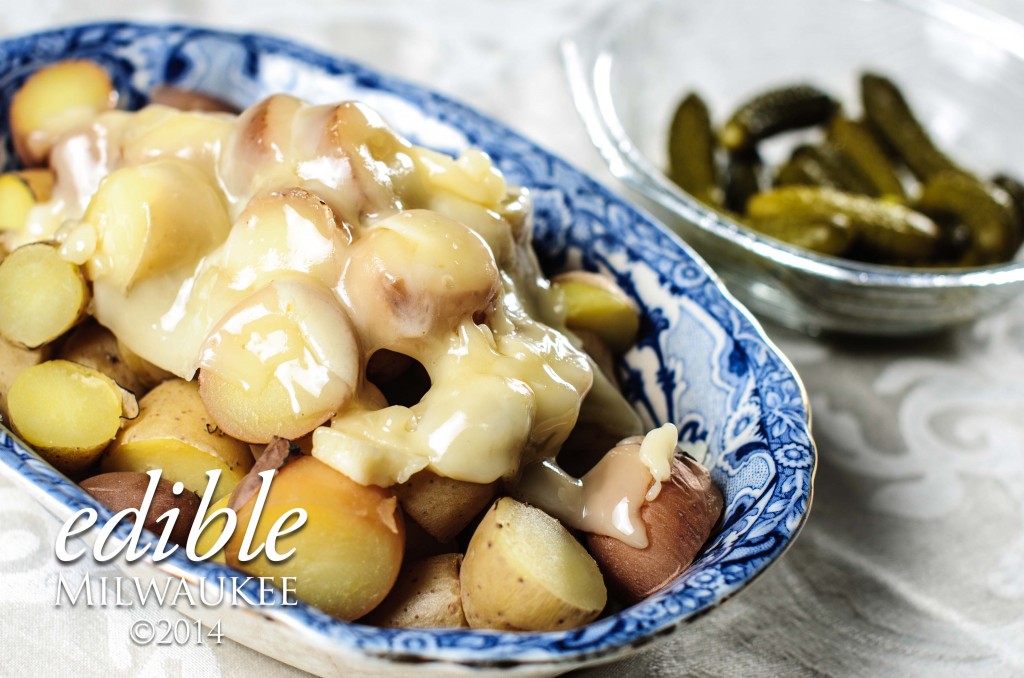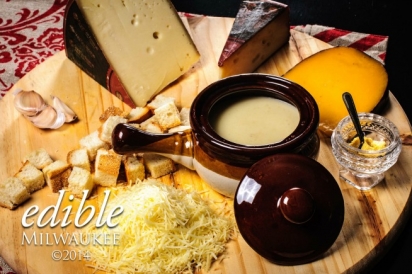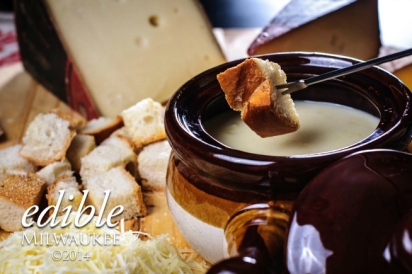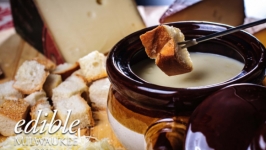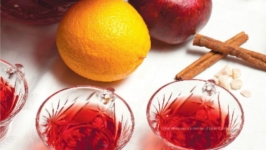Melty Cheese Melts the Heart
Do you fondue? Raclette? You bet.
When peering into the rich history of food or drink, rarely does one encounter a conspiracy. But when one does, they tend to be real doozies.
The history of whiskey, for example, is rife with tumultuous conniving, from the interloping of the English and the establishment of the excise tax in the mid-1600s, to the the formation of the Distillers Company Limited cartel in 1877.
A lesser-known conspiracy took root in Switzerland after WWI that ultimately wound its way to America and delivered unto our shores a melty, delicious tradition that has endured to this day: cheese fondue.
The name fondue derives from the French fonder, “to melt.” Its origins are humble: with limited access to fresh foods during unforgiving Alpine winters, the Swiss took to dipping stale bread into melted aged cheeses in order to sustain themselves. In time, it became the national dish.
Little do we know as we dip our crusty breadtipped forks into those cauldrons of cheese that our doing so was set into motion decades ago by a cartel of cheesemakers who dominated Switzerland’s economy for nearly a century: the Schweizerische Käseunion, or Swiss Cheese Union.
The Schweizerkäseunion formed out of a strong desire to protect the economic health of Switzerland following WWI, when the previously booming cheese export economy faltered due to global economic collapse and new trade barriers. Cheesemakers had to find ways to sell their massive stocks within Swiss borders to stave off bankruptcy, so they colluded to increase consumption.
The dirty work it took to make this happen was far less savory than the dish itself: the group set milk prices, dictated to farmers how much milk was to be produced and who they could sell to, told cheesemakers how much cheese to make and what to sell it for, and whittled variety from hundreds of types of cheeses to just seven. The Swiss government even helped subsidize the plan.
In food historian Dominik Flammer’s book, Swiss Cheese: Origins, Traditional Cheese Varieties and New Creations, a chapter criticizing the Schweizerkäseunion for its strong-arm, tradition-stifling tactics, outlines how the author was chastised by former members for “not being patriotic enough.”
By the 1950s, exports picked up again and the Schweizerkäseunion co-opted what to that point had been a favorite dish in small mountain towns: fondue. It created recipes and a marketing juggernaut with slogans like “La fondue crée la bonne humeur,” or “fondue creates a good mood.”
The juggernaut reached the U.S. at the 1964 New York World’s Fair, where fondue was featured at the Swiss Pavilion’s restaurant. From this point forward, fondue shed the more nefarious parts of its history, however little-known they were stateside, and became a hit for entertaining.
While stereotypes of fondue parties may not be entirely sloughed off today, images of feathered hair, bell bottoms, and shag carpet have given way to a more nuanced appreciation of fondue as simple, delicious comfort food.
What’s Old is New Again
The popularity of fondue may have waned since its heyday, but its familiar, comforting flavors and ability to draw people together in a convivial atmosphere have not. Many families still enjoy fondue nights, especially around the holidays, when crowding around a pot of bubbly cheese just feels right.
But as important as the dish and the social swirl around it is, what goes into the pot also deserves its due.
Rene Weber, master cheesemaker and vice president of production and international projects at Emmi Roth (USA) Inc., studied and worked for eight years to become a certified master cheesemaker in his native Switzerland, and puts his extensive knowledge to work overseeing production, research and development, quality and innovation.
“Never a dull moment,” he quipped. “But we’re very proud that we make very traditional cheese using copper vats and wooden boards. We’re very precise. It’s really an artisanal operation.”
Emmi, the largest milk buyer, processor, and producer in Switzerland, acquired Roth Cheese of Monroe, just south of Madison, in 2009. Its focus is crafting specialty cheeses in the Swiss style that have won an impressive 17 awards at prestigious state, national, and international competitions this year alone.
A recent Huffington Post story named Monroe one of the top 20 foodie cities in America alongside such gastronomic destinations as New York City, Portland (both of them, actually), and… Milwaukee. The story cited Monroe’s claim to being “the Swiss cheese capital of the USA” and home to excellent cheese shops, from Alp and Dell, which sells a great many Emmi cheeses, to Baumgartner’s, the oldest in the state.
Between the flavorful, nutty Alpine-style cheeses made here under the Roth banner—Grand Cru Reserve, Grand Cru Surchoix, and others—and the traditional Emmi cave-aged cheeses like Gruyere and Emmentaler it makes in Switzerland, Emmi Roth’s cheeses are ideally suited for fondue and its equally melty and delicious sister dish, raclette.
The earliest known recipe for cheese fondue comes from a book published in Zurich in 1699 under the name “Käss mit Wein zu kochen,” or “to cook cheese with wine.” At this early point in its history, fondue certainly didn’t have a dinner party vibe; it was simple, efficient food.
“In the Swiss Army, fondue was something you ate quite a lot,” said Weber, who, like all Swiss males, performed compulsory military service at age 20. “When you’d get your rations of cheese and wine, sometimes you put it all together and throw your bread in there and have a fondue. Those are fond memories.”
Like many others, Weber took comfort in the simplicity of dunking bread in melted cheese. Today’s fondues retain that sense of comfort, but can also be elegant.
“I love to make it when I entertain,” he said. “If people come over and I want to impress them, then I make one from scratch. It’s fun to do it in front of people and talk and drink a little wine. But it’s so easy to cook that I sometimes like to just make it for myself even if there’s nobody else in the mood.”
According to Weber, there are a few general rules to obey when selecting cheeses and making fondue.
“You want to have aged cheese, more than six months old, so the proteins are broken down to a certain level for it to melt properly,” he said. “You also look for particular flavors. I use either Grand Cru Reserve or Grand Cru Surchoix and mix in some Swiss cheese. The ratio is about two thirds cheese to one third wine.”
When cooking, Weber said heating the wine first gives the cheese something to melt into.
“Add small amounts of cheese at a time,” he instructed. “There’s always a point where it looks like it’s not going to be very creamy and nice, but you have to keep stirring. Then add some cornstarch and some kirsch and keep stirring. Before you know it, it’s nice and creamy.”
Weber added that his kids enjoy fondue quite a lot, and prefer it in the same traditional style as their dad. They wouldn’t be the first youngsters for whom fondue is a family tradition to be carried out with affection.
“I love fondue, and I make it at least once a month,” said Greg León, chef of the Walker’s Point pop-up restaurant, Amilinda. “It’s one of my earliest childhood memories. I was a child of the Seventies, so it’s kind of cliché, but when you think Seventies, you think fondue parties. I remember going to my parents’ friends house and seeing the fondue pots, and I remember when I was about 10, my family and I were traveling through the Andes and we stopped at a hotel for the night and had fondue for dinner.”
He said he uses half Emmentaler and half Gruyère, grating them into a bowl and tossing the cheese with two tablespoons of all-purpose flour; then he heats dry white wine and shallots, bringing the wine to a boil and reducing before adding handfuls of cheese bit by bit, stirring each handful to incorporate and melt before adding more.
“At the end I like to stir in at least a tablespoon of spicy Colman’s Mustard to add some heat.”
A different kind of heat plays a critical role in the enjoyment of fondue’s sibling, raclette, which is both a type of cheese, typically younger—aged 4-5 months—than the harder cheeses used in fondue, and a dish made using its namesake.
Raclette the dish is as simple as it gets: a wheel, wedge, or slice is heated by almost any means available and the resulting melted cheese is scraped or otherwise conveyed onto one of two traditional starches: boiled potatoes or crusty bread. Cornichons are often served alongside.
“In Switzerland and in Europe, raclette is a meal,” said Weber. “It’s not a starter or something that gets served beside a steak. It’s melted cheese over boiled potatoes, with some sour dill pickles, and a glass of white wine. That’s a meal. The same is true for fondue. In the States, these things are often considered starters.”
However it’s eaten, raclette—essentially street food in Switzerland—is every bit the party animal fondue is, perhaps even more.
“I have a tradition at my house that every Christmas Eve, I have an open house for all my neighbors and they can bring all their guests, and I make a raclette,” said Weber. “I have a special contraption that heats it from the top, so I put an entire wheel onto the heat source, and I scrape the melted cheese onto the plate. I serve it with little boiled potatoes and white wine. In the eight years we’ve done this, it’s turned into almost a block party because everybody comes. It used to be an hour, now it’s the whole evening.”
In Weber’s estimation, raclette makes for a much different type of entertaining than its more common brother.
“Fondue is very intimate,” he explained. “You sit together around the pot with four or maybe six people, you drink wine and talk, and everyone dips their fork in the same pot. It’s really good fun, but it’s an intimate affair. Raclette can also be intimate, but you can serve a much larger group.”
He continued:
“With fondue, you need to get the timing right. When it’s ready, you need to sit down. You can’t keep it bubbly forever. With raclette, you have flexibility. If people want more, you just start melting cheese again.”
But for goodness’ sake, don’t try to use another cheese for raclette.
“Raclette is the only cheese to use for this in my opinion,” Weber declared. “Our Montanella Raclette, for example, has a certain flavor and is made to melt really nicely without separating the butter, fat, and proteins the way some cheeses do.”
Science and preference aside, perhaps the clearest indicator of the enduring love for handcrafted Swiss cheeses and dishes like fondue and raclette is their ability to bring people together.
“Cheese has a different meaning in Europe because meat is extremely expensive,” said Weber. “Cheese was plentiful and was a daily meal. In the evening you’d get boiled potatoes and maybe three or four pieces of different cheeses and some butter, and that was a meal. It’s fun when you sit with your family around a little raclette oven or a fondue pot.”
Sometimes sharing a meal means sharing a tradition. Pass the crusty bread and long forks.


